Bristlenose Plecos are one of the most commonly recommended beginner catfish and pleco species, but despite their hardy nature, you still need to put in the work to accommodate them properly.
Bristlenose Plecos get up to 6 inches in size, although their exact growth is determined by the size of your tank, your water parameters, and how many other tankmates are in your tank.
If you’re wanting to keep Bristlenose Plecos–any fish for that matter–understanding how big they get is an important detail to make sure you don’t overstock your tank.
Keep reading, because I’m going to provide all the useful information you need to know about Bristlenose Pleco size and why it’s important to consider.
I’m also going to recommend some of my personal tank sizes that I’ve used for Bristlenose Plecos in the past.
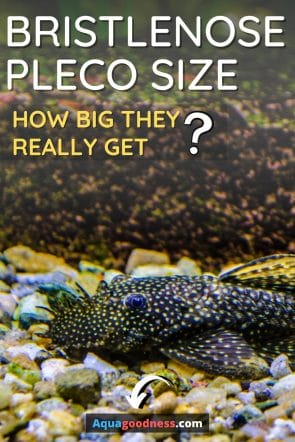
Table of Contents
How Big Do Bristlenose Plecos Get?
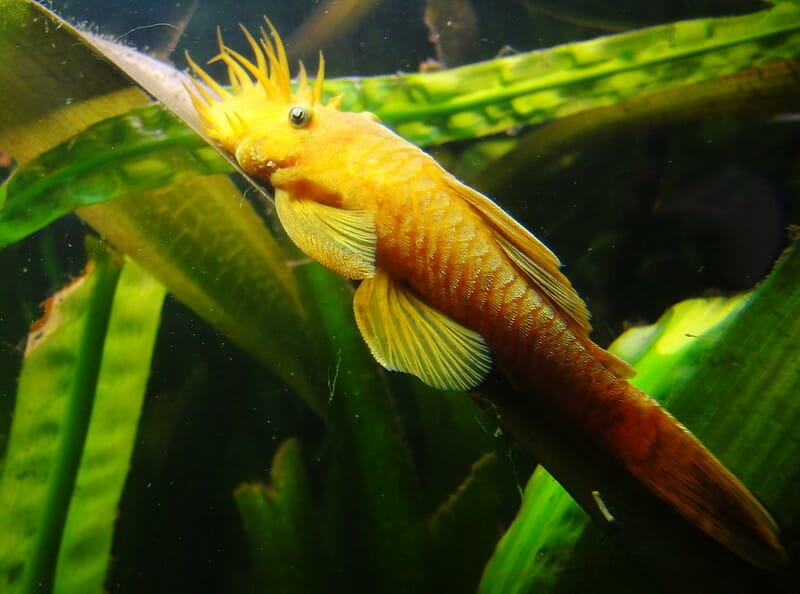
Albino Bristlenosepleco (Photo by Thomas Siems)
Bristlenose Plecos come in all shapes, sizes, and colors, each with their own slightly different sizes and tank requirements.
Here’s a breakdown of some common Bristlenose Pleco species and how you can best accommodate them.
| Species | Maximum Size |
|---|---|
| Common Bristlenose Pleco | 6 inches |
| Albino Bristlenose Pleco | 4.5 inches |
| Starlight Bristlenose Pleco | 4.5 inches |
| Super Red Bristlenose Pleco | 4.5 inches |
| Calico Bristlenose Pleco | 4.5 inches |
| Longfin Bristlenose Pleco | 5 inches |
As you can see, it’s a pretty safe bet that your Bristlenose Pleco will not get any bigger than 6 inches. In fact, the average size for a Bristlenose Pleco is 3.5 inches.
As a responsible fishkeeper, you should always assume that your fish will reach the maximum size it is capable of reaching and stock your tank accordingly. Of these species, the only one that tends to be smaller on average is the Starlight Bristlenose Pleco.
While there are exceptions, they tend to only reach a size of 4-5 inches, while other species can grow to 6 inches in length in ideal tank conditions.
Factors that Influence Size
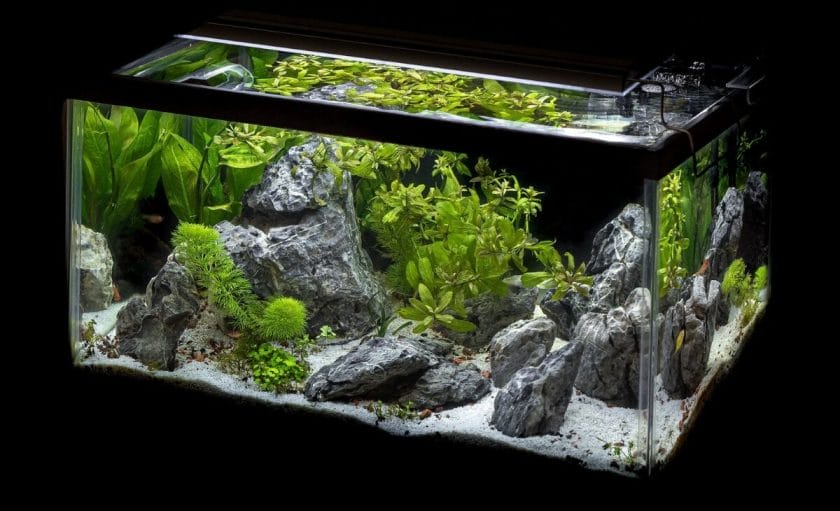
A fish’s size isn’t just determined by their genetics; in fact, your tank setup is a major component in determining how big your fish will get. Poor fishkeeping can stunt a fish’s growth, leading to an increased risk of deformities and disease.
Tank Size
Yes, the size of your tank may affect the size of your fish to some extent. In a cramped tank environment, fish cannot adequately exercise their muscles, impairing its physical development. Over time, this can result in deformities and stunting.
Naturally, these deformities can also occur as a result of genetics. A Bristlenose Pleco with a spinal deformity, for example, might still live a long and happy life, but its size will likely be affected.
The correlation between fish size and tank size isn’t proven, but some proponents argue that fish are capable of mitigating the growth hormone they produce if they are in a smaller tank, presumably for evolutionary reasons.
On the other hand, research suggests that fish don’t actually grow to fit their tank size, as the popular aquarium myth insists.
What is clear is that a too-small tank can negatively affect the well-being of a fish and cause irreparable damage and stress.
Tankmates
In a small capacity, tankmates can inhibit the growth of other fish. They may do so by limiting the amount of food that passive or weaker fish may get or causing them stress by bullying.
Both of these factors can affect the growth of an affected fish and maybe a more pressing concern for Bristlenose Plecos, who are passive and feed on the bottom of the tank.
Some species of fish also produce growth inhibitor hormones, which limit the growth of other fish of the same species in the same tank environment. If the tank is too small, then these hormones can build up and become present in higher concentrations.
Generally, growth inhibitor hormones aren’t something you need to worry about when keeping fish, but it may exacerbate an already-existing problem if your tank is too small.
Food and Oxygen
Just like humans, fish need food and oxygen to thrive. If a tank environment is scarce on food, nutrients, or oxygen, the fish’s development may suffer.
Plants and airstones can help oxygenate a tank; the latter also provides much-needed water surface movement to prevent the buildup of algae and aerate the tank.
Bristlenose plecos also need the right nutrients in the form of veggies, pellets, and algae. Without them, their growth may be impaired. Make sure to give your Bristlenose Plecos specific sinking food that your top or middle-dwelling fish will not bother with.
Because they live on the bottom, Bristlenose Plecos (and catfish as a whole) may be more affected by competition for food.
Water Parameters
Stress is the enemy of growth for the majority of fish species, and one of the most common causes of stress is poor water quality.
Most fish don’t enjoy extremes; a pH of 6.5-7.5, for example, is ideal for most fish because it isn’t too acidic or too alkaline.
There are exceptions, of course, but as a whole, it’s best to avoid sudden shifts in hardness, temperature, and pH and keep each temperate.
High nitrates, in particular, are associated with a reduced growth rate. Keep your nitrates
Gender
Lastly, female Bristlenose Plecos tend to be slightly smaller than the males, as is their biological tendency. They may only grow bristles from their mouth, whereas the males tend to grow bristles all over their bodies.
At about 2-3 inches long (6-8 months of age), you can start to sex your plecos. The males will develop spiky bristles on the center of their heads, while the females will not.
Genetics
Another factor that influences size is genetics. Two identical Bristlenose Plecos in the same tank might grow to different sizes simply due to their genetics. Nothing can be done to change this fact, and it’s not something that detrimentally affects the smaller or larger fish’s growth.
The most common example of genetics at play is the difference in size between a wild Bristlenose Pleco and one in captivity.
Wild Bristlenose Plecos can grow up to 8 inches, while in captivity, finding a 6-inch pleco is rare indeed.
How Fast Does a Bristlenose Pleco Grow?

Bristlenose Plecos grow slowly in their first 3 months, usually staying at about an inch in size. Then, they have a spurt from the 3 to 6-month mark, after which they’ll grow more slowly again.
Bristlenose Plecos do the majority of their growth during the first year of their life, after which their growth rate slows down significantly until they reach the 2-year mark.
At about 2 years, they are done growing and have reached their full size. The average size is 3.5 inches, but a standard Bristlenose Pleco range is 3-5 inches.
Of course, the best way to ensure a Bristlenose Pleco fry grows quickly is to put it in a separate tank. That way, it’s not susceptible to predators in another tank or to diseases, infections, or changes in tank parameters that may affect a community tank.
A 20-gallon tank is perfect for raising fry. Bristlenose Plecos will also grow slightly faster in warmer water, as it increases their metabolism.
How Big Should a Bristlenose Pleco Tank Be?
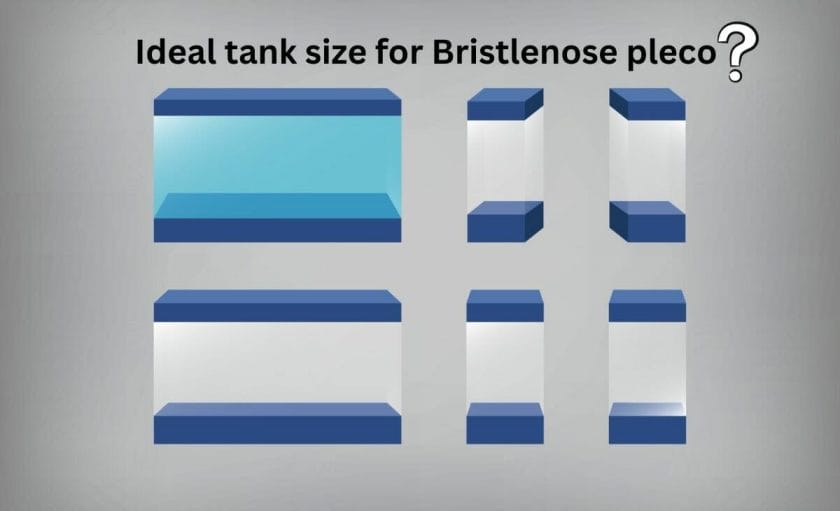
The best answer for the ideal tank size for a Bristlenose Pleco is “It depends.” At a minimum, your pleco should be kept in a 30-gallon tank, as anything smaller risks stunting.
Always assume your pleco will reach the higher end of its growth range and plan accordingly. For the first few months, a 20-gallon tank is acceptable, ideally with lots of plants for the pleco fry to hide and develop safely.
Odds are, you’re going to put Bristlenose Plecos with other fish. If so, a 20 gallon tank might end up overstocked very quickly. I’d recommend at least 50+ gallons if you plan to keep multiple Bristlenose Plecos.
They are solitary fish by nature and territorial, but they do prefer to live near others of their kind in ‘groups’ of 2-5. Filling your tank with plecos is a great way to add movement to the bottom and keep your plants, tank wall, and decorations free of algae.
A larger tank not only provides your Bristlenose Plecos room to grow, but it also allows you to provide them with plenty of places to hide.
Of course, if you’re planning to add other fish to your tank, you should plan accordingly. The general rule is that 1 inch of fish equals 1 gallon of tank space.
This rule of thumb can be generally helpful for stocking your tank, but it’s important to remember that this rule does not apply to all species, as different species of fish, invertebrates, and gastropods produce different levels of waste.
Pleco is one such example of a high-waste fish. Yes, they can help clean algae, but they won’t address the underlying cause, and their bioload may exacerbate the problem.
Stocking your tank should be surgical in nature. Add fish slowly, monitor your tank, and prioritize stability above all to keep your fish happy and healthy in a well-stocked tank.
The Correlation between Size and Health
While size isn’t the only indicator of well-being, it’s still something worth considering. Most conditions that negatively affect the size or development of your fish are related to stress.
A higher concentration of nitrates, for example, can cause stunting, indicating that you need to dilute your tank water more frequently.
Other water conditions such as temperature, hardness, water movement, and pH can negatively affect your fish. Test your tank regularly to watch for changing tank conditions and address the root cause of chemical changes.
A lack of food can also cause Bristlenose Plecos who are unable to get the nutrients they need to appear emaciated. Make sure you give your fish algae tablets.
My favorite is the Hikari Algae Wafers. Other fish don’t bother with it, making sure that your Bristlenose get more than just the scraps from feeding time.
Driftwood, too, is an important part of Bristlenose Pleco’s diet, providing them essential fiber and nutrients that can prolong their life and encourage them to thrive.
Lastly, stress induced by predators can cause Bristlenose Plecos not to grow. Pairing Bristlenose Plecos with semi-aggressive fish can be ok in some situations, but it’s essential that you provide plants and decorations for your plecos to hide away so that they’re not harassed all the time.
Damage from semi-aggressive fish doesn’t just directly impact the fish’s well-being. The stress of being constantly harassed can impair their capacity for growth, impacting their quality of life in the long run.
FAQs
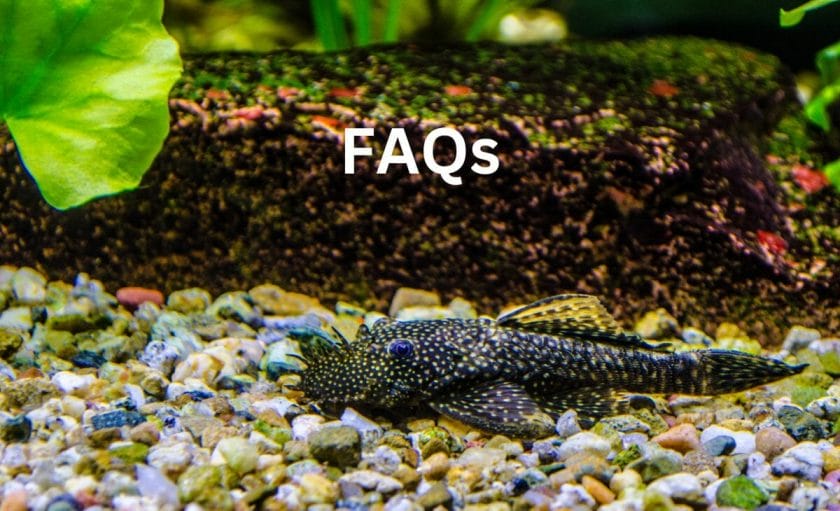
Can a Bristlenose Pleco Live in a 10-Gallon Tank?
A Bristlenose Pleco should not be kept in a 10-gallon tank, as it is too small for their needs. The lack of space can cause stress, both from the cramped conditions and the inevitable poor water quality from keeping a fish in a tank that’s too small.
How Do I Know If My Tank Is Big Enough for My Bristlenose Plecos?
Constant testing and monitoring can help you determine if your tank is the appropriate size. If your tank is the right size, then your tank’s bacteria colony should be keeping up with the waste produced by the fish, creating stable tank conditions.
Conclusion
Bristlenose Plecos are great starter fish that are hardy and get to a pretty decent size. They also live quite long, making them a great companion, especially if you’re just getting into fish keeping.
Understanding how big different species of bristlenose plecos get is important so that you can house them properly, as the right size tank and water conditions lead to a long, healthy life for your fish!
Make sure to pay attention to the useful chart and information provided above to determine which type of Bristlenose Pleco is best suited for your tank, as well as how you can best take care of them to keep them as long-term companions!
If you want to know more about plecos and know for sure whether they are actually good for your aquarium or not, please read this article.